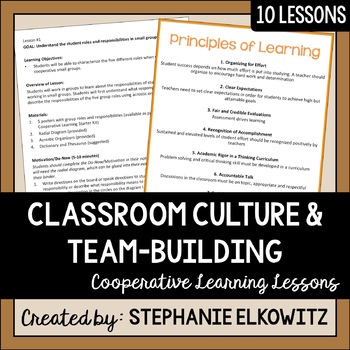Cooperative Learning Lessons
- PDF
Description
This collection of cooperative learning lessons will help you promote student autonomy and group work and will improve or establish a positive and encouraging classroom culture. Furthermore, these lessons will help you introduce cooperative learning to your students and help your students understand the philosophy of cooperative learning.
These lessons are important to a teacher who wishes to implement cooperative learning in a classroom with students who are unfamiliar with cooperative learning. They help the teacher and students understand their respective roles, embrace student-centered learning and understand the philosophy and importance of students taking charge of their learning.
More importantly, they encourage better teaching and learning practices in any and every classroom. These lessons are a great addition to a classroom aiming to improve its culture and atmosphere. They improve student focus, work ethic and understanding of the learning process. They instill appreciation for why students are in a classroom and how they can apply knowledge they gain to the world beyond the classroom.
**Be sure to download the Cooperative Learning Lesson Starter Kit, a FREE resources to help you implement these lessons.
All materials provided except for scissors, tape or glue and markers/crayons/colored pencils.
Summary of Lessons:
Lesson 1: Understand group roles
-Students will work in groups to learn about the responsibilities of student roles when working in small groups. Students will first understand what responsibility is and then describe the responsibilities of the five group roles using acrostic organizers.
Lesson 2: Learn effective communication skills
-Students will learn how to effectively communicate their opinion and feelings. They will work in small groups to study the skills of effective communication. Extended activities included!
Lesson 3: Use effective communication to address common small group problems and decision
-The students will apply effective communication skills in a small group setting to deal with common conflicts and decisions students will have to make. They will role play and perform a short skit in front of the class to demonstrate how to handle that situation.
Lesson 4: Identify and tackle learning challenges
-In this lesson, the students will discuss what effort is and how and why its important to learning. They will identify the “easy way” and “hard way” of handling certain school and learning related challenges in order to achieve one’s personal best.
Lesson 5: Understand teacher expectations and different forms of assessments
-In this lesson, students will study different forms of assessments that you will use in your classroom to evaluate their performance. The teacher will introduce (or review) his/her expectations of the students and demonstrate how an assessment is used to measure whether or not a student is meeting expectations. Students will work in small groups to study the different forms of assessments and will compare and contrast what assessments should be used to measure certain expectations.
Lesson 6: Bloom's Taxonomy Cube
-Students will work in small groups to make a Bloom’s Cube – a three-dimensional cube with the 6 levels of Bloom’s taxonomy described on each side of the cube with an “I can...” statement. The students will then work in their small groups to play a game during the large group activity.
Lesson 7: Problem-based learning exercise
-Students will work in their small groups in this lesson to solve a problem. Problem-solving in small groups requires great focus, productivity and effective communication. A successful lesson will be one where student use effective communication skills to solve the problem.
Lesson 8: Understanding and responding to teacher feedback
-Students will work in small groups to determine how to react to feedback from teachers. They will interpret common comments that are frequently left by teachers and then will develop a plan to respond to the feedback.
Lesson 9: Creating a learning and time management plan
-Students will create an individualized learning and time management plan. These will help students manage time and tackle learning challenges. Each individual student will create the plan with feedback and input from their small groups.
Lesson 10: Creating a "Teacher Code of Conduct"
-Students will first compare and contrast the role of the teacher and students in the classroom. They will work in small groups to create a list of responsibilities the teacher has to the students.
These lessons can be adapted for any level of student in any classroom.
Each lesson includes a Goal, Learning Objective, Materials, Motivation or Do-Now, Teacher Modeling, Small Group Activity, Large Group Activity, Reflection and Teacher Wrap-Up.
Be sure to check out my Problem-Based Learning Disease Diagnosing Activities too!


